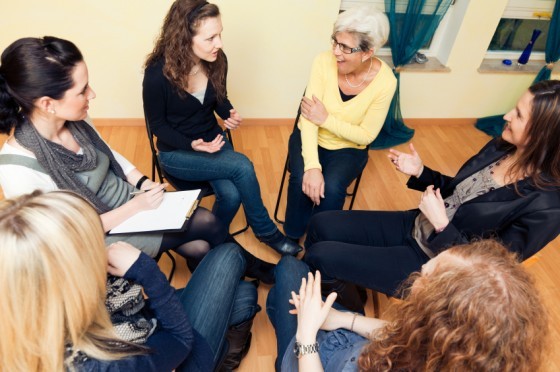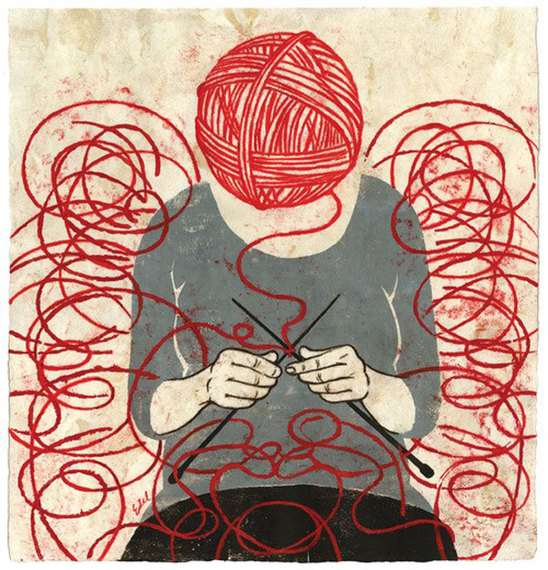This blog is the sixth part of a nine-part series chronicling Iris' 46-year battle with bulimia. To read the first, second, third, fourth and fifth parts, go here and here and here and here and here.
I welcome the change from being a director at work to being an outpatient at the treatment center. Someone is caring for me. Someone is monitoring me.
I relax the reins. It feels safe there. Contained. Warm and dusky. Like I imagine a womb.
I arrive at 4 p.m. on Monday, Tuesday and Thursday every week and stay until 7 p.m. We have group and individual therapy each day, with dinner in between. I learn to draw out the dinnertime routine. I spend 15 minutes choosing my foods, getting my napkin and silverware, deciding on a drink, selecting my salad dressings. I have never experienced languishment in a meal setting and it soothes me.
I am acutely aware of the stretches of time between courses and the pauses after a few bites. I make conversation with the fellow "sufferer" I am sitting next to each night. I am aware of the staff's hovering presence. I engage them in conversation too sometimes.
One spring evening, after dinner, the group leader poses a question with seeming casualness.
"What are the triggers propelling you to abuse food?" she inquires. "To use it in other ways than the intended way -- which is to nourish and sustain your body?"
Hmmm," I wonder, "What propels me to head for the freezer for ice cream when I'm not even hungry?"
Quite surprisingly, the answer comes readily to me: FRUSTRATION.
"I get stuck. Or I stumble in an activity. Or I hit a temporary roadblock," I relate to the group. "And then, my mouth begins to salivate and immediately my mind swerves to what food I can eat -- right this minute -- to provide me with a reprieve from the discomfort enveloping me."
The therapist probes further. "What can you do to alter your automatic negative and destructive response to frustration?"
I'm thrown into neutral gear by that question. I stall. "I can't think what to do," I admit. "Except, of course, eat everything in sight. And then throw it all up. That soothes me."
It's clear to everyone in the group, including me, that I need to find other activities that calm me -- that will induce a state of relaxation.
My immediate thoughts jump to knitting. You can't knit and binge at the same time. And as a wise knitter once quipped, "Knitting keeps you from unraveling."
The next day, I dig out my knitting needles, balls of multicolored yarn and my stitch counter -- stashed out of the way in the front hall closet under the stairs.
I started knitting in high school, mostly sweaters that didn't fit -- too tight across the bust, too short for my broad hips.
When I had babies, it was small blankets and perky little booties and caps that I churned out. My sons were too young to balk at being adorned in handmade goodies with a few dropped stitches here and there.
Then they reached a more discerning age when they could speak their mind (and it got younger and younger with each successive kid). They let me know in no uncertain terms that wearing a ski sweater knitted by their mother was at the top of the list of weird things that they were not going to do.
So I started on family room afghans, with an occasional scarf thrown in for variety. And my knitting needles clicked for many years.
I wonder why I ever stopped.
Shortly thereafter, our group receives an additional member. Singer, a young woman in her 20s, was released from inpatient treatment the week before and had spent the next seven days bingeing, purging and drinking alone in the one bedroom, un-air conditioned apartment she rents with her boyfriend -- the sub-literary brute who works at a beach hamburger shack down the road from our treatment center.
"Thank goodness," I tell myself, "I only have one substance abuse issue -- food."
Others in here, I am finding, have alcohol and drug issues -- some even cutting issues. Mine is just food, glorious food. In a sense, I am fortunate: I don't have to stop eating, like others have to stop their vices altogether. My path to freedom lies in re-orienting and re-training myself to view food as a source of sustenance, fuel, and, yes, even pleasure.
Following her relapse, Singer shows up in outpatient therapy. I eye her warily. She is a mess. Despondent. Despairing. Dirty. Her mouth is slack, her eyes glazed, her hair tangled, her complexion pasty.
My first reaction is to turn away. Self protect -- as if her stumbling is contagious. I recoil in fear, moving closer to my chum Ari, who is inappropriately infatuated with an older fellow, an adjunct Math professor at the local community college.
"What do you like to do, Singer?" our group leader probes gently, "in your free time?"
Her question is met with silence. I detect a stiffening of Singer's shoulders.
I am almost at the point of not listening to her interaction with the group leader, when something Singer murmurs catches my attention.
"I like to do things with my hands," Singer replies, rather sheepishly. "When I was a little girl," she continues meekly, "I liked those looms you bought at the dime store -- the ones that made those colorful pot holders you gave your mom on Mother's Day."
"Try knitting," I call out spontaneously, surprised at my own reaction to her remarks. "It's hard to binge and drink when you are holding two knitting needles in your hands."
My companions laugh. And to my surprise, Singer's deer-caught-in-a-headlight gaze fades just a tad.
The next night I bring her an old stripped beach bag filled with knitting needles, three balls of different colors of yarn and an instruction book. I hand it to her, uncertain of her reaction.
A broad smile appears on her pinched face, as she tentatively reaches out for my gift. And I realize how very pretty she really is.
As always, I welcome your comments, your feedback, your thoughts.
If you want more information about my forthcoming book Tales of a Bulimic Baby Boomer, or to sign up for my weekly newsletter, visit www.irisruthpastor.com or follow me on Twitter @IrisRuthPastor.
You can find more from me on LinkedIn too.
Earlier on Huff/Post50:



